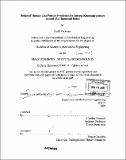| dc.contributor.advisor | Cynthia Breazeal. | en_US |
| dc.contributor.author | Thomann, Derik (Derik S.) | en_US |
| dc.contributor.other | Massachusetts Institute of Technology. Dept. of Mechanical Engineering. | en_US |
| dc.date.accessioned | 2006-05-15T20:42:22Z | |
| dc.date.available | 2006-05-15T20:42:22Z | |
| dc.date.copyright | 2005 | en_US |
| dc.date.issued | 2005 | en_US |
| dc.identifier.uri | http://hdl.handle.net/1721.1/32964 | |
| dc.description | Thesis (S.B.)--Massachusetts Institute of Technology, Dept. of Mechanical Engineering, 2005. | en_US |
| dc.description | Includes bibliographical references (p. 53-54). | en_US |
| dc.description.abstract | A method and system has been developed to solve the kinematic redundancy for a humanoid redundant manipulator based on forward kinematic equation and the optimization of human-like constraints. The Multiple Objective Optimization (MOO) is preformed using a Genetic Algorithms (GA) and implemented using the Genetic and Evolutionary Algorithm Matlab Toolbox. The designed system is illustrated on a simple redundant 3 degree of freedom (dof) manipulator and is set up for a more complicated redundant 7 dof manipulator. The 7 dof manipulator is modeled from the Stan Winston studio's Leonardo, an 61 dof expressive humanoid robot. It has been found that the inverse kinematic solution to a 3dof model arm converged within 1% error of the solution within .05 mins processor time using the discomfort human-like constraint in 2d space. Similarly, the inverse kinematic solution to a 7 dof model arm consisting of Leonardo's right arm geometry was found to converge within 1% error within .20 mins processor time using the discomfort human-like constraint in 3D space. The full kinematic model of Leonardo is developed and future efficiency optimizations are posed to move towards the real-time motion control of a redundant humanoid robot by way of human-like posture prediction. | en_US |
| dc.description.statementofresponsibility | by Derik Thomann. | en_US |
| dc.format.extent | 63 p. | en_US |
| dc.format.extent | 2215294 bytes | |
| dc.format.extent | 2217266 bytes | |
| dc.format.mimetype | application/pdf | |
| dc.format.mimetype | application/pdf | |
| dc.language.iso | eng | en_US |
| dc.publisher | Massachusetts Institute of Technology | en_US |
| dc.rights | M.I.T. theses are protected by copyright. They may be viewed from this source for any purpose, but reproduction or distribution in any format is prohibited without written permission. See provided URL for inquiries about permission. | en_US |
| dc.rights.uri | http://dspace.mit.edu/handle/1721.1/7582 | |
| dc.subject | Mechanical Engineering. | en_US |
| dc.title | Design of human-like posture prediction for inverse kinematic posture control of a humanoid robot | en_US |
| dc.type | Thesis | en_US |
| dc.description.degree | S.B. | en_US |
| dc.contributor.department | Massachusetts Institute of Technology. Department of Mechanical Engineering | |
| dc.identifier.oclc | 62860123 | en_US |
